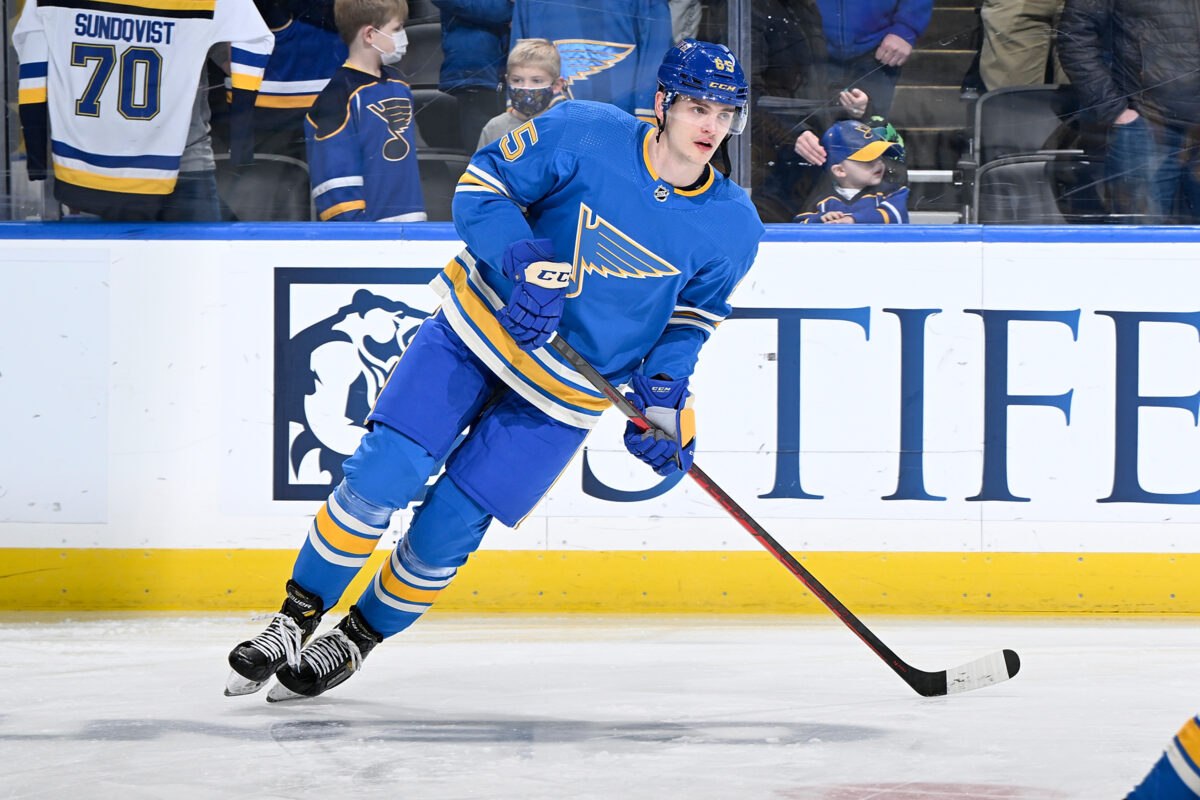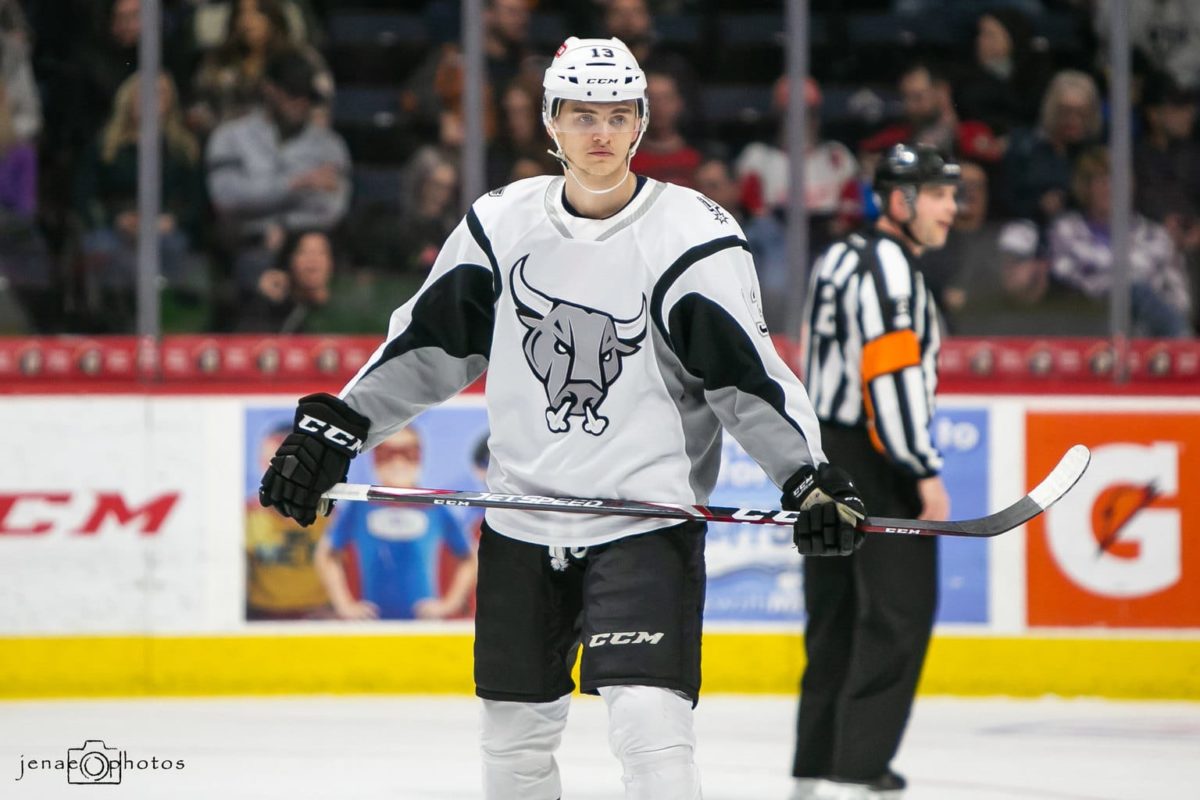Alexey Toropchenko was never considered one of the St. Louis Blues‘ top prospects, a promising phenom, or a player who would leave a footprint in the NHL. Reflecting back on all available scouting reports leading up to the 2017 NHL Entry Draft, it didn’t seem like many felt that he could thrive in the NHL. And after one and a half seasons in the NHL, he’s proven all skeptics wrong.

Toropchenko made his first appearance in the NHL back on Dec. 14, 2021, against the Dallas Stars. In that game, he had 12 shifts and saw a little over eight minutes on the ice. In those eight minutes, he had two shots on goal and two hits but was unable to record a goal or assist. And although his NHL debut was a bit lackluster, he has now become a regular in the Blues’ lineup.
The Background of Alexey Toropchenko
Looking back on Toropchenko’s history in juniors and the Kontinental Hockey League (KHL), he was never considered a “point-getter”. He was never going to wow anybody in terms of production like some top prospects would, however, looking back at his time in the Ontario Hockey League (OHL) with the Guelph Storm, there was obviously something there.
In two seasons of hockey, he played 128 games in which he had 34 goals and 48 assists for a total of 82 points. Additionally, he had a playoff stint back in 2018-19 that lasted 24 games. In those 24 games, he produced a total of 13 goals and six assists for 19 points. And it was those statistics and his play in the OHL that caught the eye of general manager, Doug Armstrong.
Scouting Report
Toropchenko, as stated above, isn’t a point-getter. He’s never really going to produce at a top-line level. He doesn’t have the puck skills that would allow him to thrive in a position like that. However, despite his inability to be a primary puck-handler, he does offer a lot to the Blues at this point in time.
Since making his NHL debut, he’s done nothing but be consistent in his play. And given the fact he doesn’t have an x-factor to his game, he has to impress by doing the little things properly; and that is exactly what he has done. But, more than that, he has a lot of speed to his game as well.

Every game to this point, Toropchenko has been one of the most notable players on the ice. Between his physical play and speed, he skates and wears down his opponents every time he steps foot on the ice. Additionally, he’s grown a lot in terms of his hockey IQ over the last couple seasons. Playing on a line with Oskar Sundqvist and Sammy Blais at the start of the season has more than helped him in that aspect. As for his offensive play, there has been a significant jump as well.
Toropchenko’s defensive play has taken a rather large step up from where it originally was, but not near as large as his offensive game. He still isn’t much of a puck-handler, but he has become significantly more confident in the overall offensive part of his game. But, how has Toropchenko’s performance this season helped the Blues? Well, it’s quite simple.
The Metrics Behind the Story
When it comes to looking at metrics to help you understand a player’s value, it’s not always accurate. However, since more advanced metrics have come out, certain things have become more clear. Analytics are a part of the game, and the most intriguing one is the offensive zone-defensive zone percentage. And looking at those statistics this season and comparing them against last season, Toropchenko’s jump is quite significant.
Related: Blues’ 2023-24 Stats Predictions: Forwards
Last season, Toropchenko’s offensive zone percentage/defensive zone percentage ratio was 37.1/62.9. So, to elaborate, while Toropchenko is on the ice, the Blues were in the offensive zone 37.1 percent of the time and in the defensive zone 62.9 percent of the time. This season, however, he has an offensive zone percentage of 48.2 and a defensive zone percentage of 51.8; roughly a 10-point swing in the Blues’ favor. Another point to make while on this topic, Toropchenko, while on the penalty kill has a 40 percent offensive zone possession percentage.
What’s Toropchenko’s Ceiling?
Looking at Toropchenko’s start in the NHL, it’s hard to figure out what he is capable of since he hasn’t really been given a chance to show everything he has to offer. Having been on the Blues’ third and fourth lines since coming into the league, he hasn’t been given the chance to show head coach Craig Berube and the rest of the coaching staff whether or not he can be a top-line player. However, he isn’t the only player who hasn’t been given the chance to show what he can do. When looking around the league to try and find a comparison, there was one name that has a striking resemblance to Toropchenko, and funny enough, he is a former Russian Blues forward – Ivan Barbashev.
Barbashev, since getting drafted by the Blues, has been a bottom-six forward due to his style of play. He is a physical, hard-working forward with some hidden goal scoring talent; just like Toropchenko. More so than that, Barbashev was a big piece to the puzzle on the penalty kill and power play which I think Toropchenko has the ability to become.
Right now, Toropchenko is on the Blues’ second penalty kill unit. However, unlike Barbashev, he isn’t on the power play. But, I do think that he could soon find minutes on the power play if he can continue developing as a net-front presence and improving his hockey IQ in the offensive zone.
“The little things”. That’s what Berube preaches in his post-game conferences. Understanding the game a bit better in terms of when to press and when to drop back into a soft zone, when to shoot the puck and when to make a pass, when to carry the puck and when to make a stretch pass in transition, they are all things that he needs to improve on. But, if Toropchenko can continue improving like he has been, then he could put himself on a path to potentially bring his name right alongside a player like Reilly Smith. For now, however, Barbashev seems to be the best comparison for Toropchenko and where he is at in his career.
Toropchenko’s Future with the Blues
Getting a read on Toropchenko’s future is tough. He has shown to be reliable, and when the Blues play badly, he seems to be one of the bright spots on the team. More so than that, he is doing it at a relatively low annual salary which makes his value perhaps the best on the Blues on a day-to-day basis. However, he has yet to really explode in terms of production, and at the end of the day, production means a great deal in this league when it comes to long-term contracts.
It’s not that Toropchenko can’t produce, because he has the shot to beat goalies clean. We’ve seen him do it on multiple occasions. But he needs to continue working on it and getting a bit more comfortable shooting from the point. Developing a one-timer from the dot wouldn’t hurt either. Additionally, he has a little bit of skill and size that allows him to execute on grade-A chances in front of the net. If he can learn to continue shooting and finding the proper lanes, then we could see him increase his goal total quite substantially. As for his playmaking statistics, it’s all about enhancing his hockey IQ.
Understanding when to shoot and when to pass is a huge part of the game and it comes with time and experience. Something that Toropchenko has yet to really get. But as he continues to develop chemistry with his linemates, he will get more comfortable making that extra pass to the point for a potential one-timer. And he will continue to develop that sixth sense to know when to pass and when to shoot.
As he continues to develop those traits, Toropchenko could find himself a spot on this Blues team long-term. But, it all depends on how he continues to develop and progress throughout the remainder of his contract.
